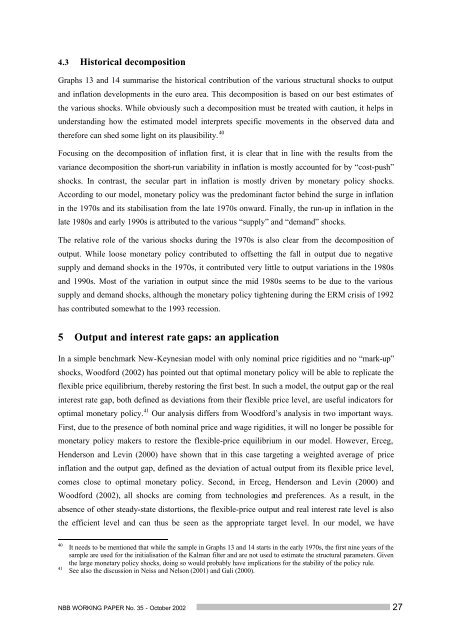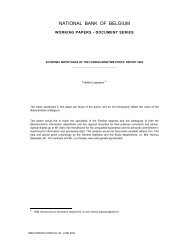An estimated dynamic stochastic general equilibrium model of the ...
An estimated dynamic stochastic general equilibrium model of the ...
An estimated dynamic stochastic general equilibrium model of the ...
You also want an ePaper? Increase the reach of your titles
YUMPU automatically turns print PDFs into web optimized ePapers that Google loves.
4.3 Historical decompositionGraphs 13 and 14 summarise <strong>the</strong> historical contribution <strong>of</strong> <strong>the</strong> various structural shocks to outputand inflation developments in <strong>the</strong> euro area. This decomposition is based on our best estimates <strong>of</strong><strong>the</strong> various shocks. While obviously such a decomposition must be treated with caution, it helps inunderstanding how <strong>the</strong> <strong>estimated</strong> <strong>model</strong> interprets specific movements in <strong>the</strong> observed data and<strong>the</strong>refore can shed some light on its plausibility. 40Focusing on <strong>the</strong> decomposition <strong>of</strong> inflation first, it is clear that in line with <strong>the</strong> results from <strong>the</strong>variance decomposition <strong>the</strong> short-run variability in inflation is mostly accounted for by “cost-push”shocks. In contrast, <strong>the</strong> secular part in inflation is mostly driven by monetary policy shocks.According to our <strong>model</strong>, monetary policy was <strong>the</strong> predominant factor behind <strong>the</strong> surge in inflationin <strong>the</strong> 1970s and its stabilisation from <strong>the</strong> late 1970s onward. Finally, <strong>the</strong> run-up in inflation in <strong>the</strong>late 1980s and early 1990s is attributed to <strong>the</strong> various “supply” and “demand” shocks.The relative role <strong>of</strong> <strong>the</strong> various shocks during <strong>the</strong> 1970s is also clear from <strong>the</strong> decomposition <strong>of</strong>output. While loose monetary policy contributed to <strong>of</strong>fsetting <strong>the</strong> fall in output due to negativesupply and demand shocks in <strong>the</strong> 1970s, it contributed very little to output variations in <strong>the</strong> 1980sand 1990s. Most <strong>of</strong> <strong>the</strong> variation in output since <strong>the</strong> mid 1980s seems to be due to <strong>the</strong> varioussupply and demand shocks, although <strong>the</strong> monetary policy tightening during <strong>the</strong> ERM crisis <strong>of</strong> 1992has contributed somewhat to <strong>the</strong> 1993 recession.5 Output and interest rate gaps: an applicationIn a simple benchmark New-Keynesian <strong>model</strong> with only nominal price rigidities and no “mark-up”shocks, Woodford (2002) has pointed out that optimal monetary policy will be able to replicate <strong>the</strong>flexible price <strong>equilibrium</strong>, <strong>the</strong>reby restoring <strong>the</strong> first best. In such a <strong>model</strong>, <strong>the</strong> output gap or <strong>the</strong> realinterest rate gap, both defined as deviations from <strong>the</strong>ir flexible price level, are useful indicators foroptimal monetary policy. 41 Our analysis differs from Woodford’s analysis in two important ways.First, due to <strong>the</strong> presence <strong>of</strong> both nominal price and wage rigidities, it will no longer be possible formonetary policy makers to restore <strong>the</strong> flexible-price <strong>equilibrium</strong> in our <strong>model</strong>. However, Erceg,Henderson and Levin (2000) have shown that in this case targeting a weighted average <strong>of</strong> priceinflation and <strong>the</strong> output gap, defined as <strong>the</strong> deviation <strong>of</strong> actual output from its flexible price level,comes close to optimal monetary policy. Second, in Erceg, Henderson and Levin (2000) andWoodford (2002), all shocks are coming from technologies and preferences. As a result, in <strong>the</strong>absence <strong>of</strong> o<strong>the</strong>r steady-state distortions, <strong>the</strong> flexible-price output and real interest rate level is also<strong>the</strong> efficient level and can thus be seen as <strong>the</strong> appropriate target level. In our <strong>model</strong>, we have4041It needs to be mentioned that while <strong>the</strong> sample in Graphs 13 and 14 starts in <strong>the</strong> early 1970s, <strong>the</strong> first nine years <strong>of</strong> <strong>the</strong>sample are used for <strong>the</strong> initialisation <strong>of</strong> <strong>the</strong> Kalman filter and are not used to estimate <strong>the</strong> structural parameters. Given<strong>the</strong> large monetary policy shocks, doing so would probably have implications for <strong>the</strong> stability <strong>of</strong> <strong>the</strong> policy rule.See also <strong>the</strong> discussion in Neiss and Nelson (2001) and Gali (2000).NBB WORKING PAPER No. 35 - October 2002 27
















